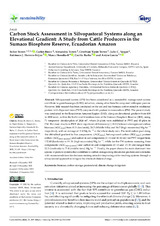Mostrar el registro sencillo del ítem
Carbon Stock Assessment in Silvopastoral Systems along an Elevational Gradient: A Study from Cattle Producers in the Sumaco Biosphere Reserve, Ecuadorian Amazon
| dc.contributor.author | Torres, Bolier | |
| dc.contributor.author | Bravo, Carlos | |
| dc.contributor.author | Torres, Alexandra | |
| dc.contributor.author | Tipán-Torres, Cristhian | |
| dc.contributor.author | Vargas, Julio C. | |
| dc.contributor.author | Herrera-Feijoo, Robinson | |
| dc.contributor.author | Heredia-R, Marco | |
| dc.contributor.author | Barba, Cecilio | |
| dc.contributor.author | García, Antón | |
| dc.date.accessioned | 2023-03-03T12:00:55Z | |
| dc.date.available | 2023-03-03T12:00:55Z | |
| dc.date.issued | 2023 | |
| dc.identifier.uri | http://hdl.handle.net/10396/24862 | |
| dc.description.abstract | Silvopastoral system (SPS) has been considered as a sustainable management system contribute to greenhouse gas (GHG) reduction, among other benefits compared with open pasture. However, little research has been conducted on the soil and tree biomass carbon stored in traditional pasture with dispersed trees (PWT) compared with pasture in monoculture (PM). The present study was conducted in the Ecuadorian Amazon Region (EAR), along an elevational gradient from 400 to 2000 masl., within the buffer and transition zone of the Sumaco Biosphere Reserve (SBR), using 71 temporary circular plots of 2826 m2, where 26 plots were stablished in PWT and 45 plots in PM. The main results in PWT show significant differences (p ≤ 0.01) between aboveground carbon biomass (AGCtrees) from 41.1 (lowlands), 26.5 (Middle hills) and 16.7 (high mountains) Mg ha−1 respectively, with an average of 31.0 Mg ha−1 in the whole study area. The total carbon pool along the altitudinal gradient in five components: (AGCtrees), belowground carbon (BGCtrees), pasture carbon (AGClitter+pasture) and carbon in soil components (0–10 and 10–30 cm) for PWT ranged from 112.80 (lowlands) to 91.34 (high mountains) Mg ha−1; while for the PM systems assessing three components (AGClitter+pasture) and carbon in soil components (0–10 and 10–30 cm) ranged from 52.5 (lowlands) to 77.8 (middle zone) Mg ha−1. Finally, the paper shows the main dominant tree species in pasture systems that contribute to carbon storage along elevational gradient and concludes with recommendations for decision-making aimed at improving cattle ranching systems through a silvopastoral approach to mitigate the effects of climate change. | es_ES |
| dc.format.mimetype | application/pdf | es_ES |
| dc.language.iso | eng | es_ES |
| dc.publisher | MDPI | es_ES |
| dc.rights | https://creativecommons.org/licenses/by/4.0/ | es_ES |
| dc.source | Sustainability, 15(1), 449 (2023) | es_ES |
| dc.subject | Biomass | es_ES |
| dc.subject | Carbon storage | es_ES |
| dc.subject | Pastureland | es_ES |
| dc.subject | Climate change mitigation | es_ES |
| dc.title | Carbon Stock Assessment in Silvopastoral Systems along an Elevational Gradient: A Study from Cattle Producers in the Sumaco Biosphere Reserve, Ecuadorian Amazon | es_ES |
| dc.type | info:eu-repo/semantics/article | es_ES |
| dc.relation.publisherversion | https://doi.org/10.3390/su15010449 | es_ES |
| dc.rights.accessRights | info:eu-repo/semantics/openAccess | es_ES |

